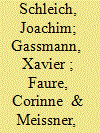|
|
|
Sort Order |
|
|
|
Items / Page
|
|
|
|
|
|
|
| Srl | Item |
| 1 |
ID:
179720


|
|
|
|
|
| Summary/Abstract |
In the last decade, there have been several initiatives to incentivize Efficient Energy Technologies (EET) to reduce air pollution caused by wood-burning in developing countries. More efficient woodstoves can improve health, reduce family expenditures, CO2 emissions, and forest degradation. Despite these benefits, there is low level of adoption of EETs. This paper contributed to the literature in three ways. First, it estimates the implicit discount rate (IDR) used by individuals to decide whether to adopt EET using exponential and hyperbolic specifications. Second, it includes sociodemographic characteristics in the definition of the IDR. Third, it evaluates how the adoption curve changes by different policy designs. Since the interest rate is part of the policy design, comparing the interest rate and the IDR is relevant to increasing adoption. Our monthly estimated IDR is between 1.7% and 5.4% with a significant overlap with market interest rate. The IDR is affected by the perception of the future economic situation, trust in environmental authorities, happiness, and gender. We found that using an interest rate lower than the IDR increases the probability of adoption significantly. An understanding of the effects of copayments, payment frequencies, and difference between interest rates and IDR is needed to maximize adoption.
|
|
|
|
|
|
|
|
|
|
|
|
|
|
|
|
| 2 |
ID:
150039


|
|
|
|
|
| Summary/Abstract |
Implicit discount rates (IDRs) are employed in energy models to capture household investment decisions, yet the factors behind the IDR and their respective implications for policy-making usually remain blurred and fractional. The proposed comprehensive framework distinguishes three broad categories of factors underlying the IDR for household adoption of energy-efficient technologies (EETs): preferences (notably over time, risk, loss, debt, and the environment), predictable (ir)rational behavior (bounded rationality, rational inattention, behavioral biases), and external barriers to energy efficiency. Existing empirical findings suggest that the factors underlying the IDRs that differ across household characteristics and technologies should be accounted for in energy models. Furthermore, the framework allows for a fresh look at the interplay of IDRs and policies. We argue that a simple observation of high IDRs (or observing correlations between IDRs and socio-economic characteristics) does not provide guidance for policy-making since the underlying sources cannot be identified. Instead, we propose that some of the factors underlying the IDR - notably external barriers - can be changed (through directed policy interventions) whereas other factors - notably preferences and predictable (ir)rational behavior - are innate and can only be taken into account (through reactive policy interventions).
|
|
|
|
|
|
|
|
|
|
|
|
|
|
|
|
|
|
|
|
|